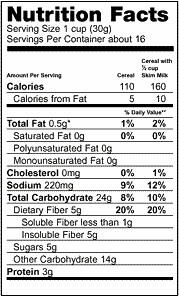Using Food Labels to determine carb content
The nutritional labels of packaged foods contain critical information for carb counting and for the insulin dosing that follows from that. But which of those many numbers in a food label matter? And how do you use them to calculate the amount of carbs in a serving of that food?
Food Labels
Labeling laws in Canada require food manufacturers to include nutrient information (for example: carbohydrate, protein and fat per serving) on product labels.
This nutritional information is presented in a standard food label format:

The basic process of label reading is relatively straight-forward:
- Identify the given Serving Size. It’s important to recognize that the information provided in this Nutrition Facts table is based on the serving size specified at the top of the table.
In our example, the serving size is listed as 1 cup, which is equivalent to 30 grams (in weight) of the product. - Determine the Total Carbohydrate in that serving size. Locate the Total Carbohydrates line and refer to the number right after “Total Carbohydrates” (in grams). (Ignore the numbers followed by % signs – these are useful for comparing different products and making healthy choices, but are not involved in determining grams of carbs.)
In our example, this is 24g of carbs. - Determine the Available Carbs. Since fibre is not broken down in the process of digestion, it does not affect blood glucose, and therefore needs to be subtracted from the Total Carbohydrate determined in (3). The Canadian recommendations are to subtract out all of the grams of dietary fibre (versus American guidelines which suggest subtracting out half of the dietary fibre).
In our example, Dietary Fibre is 5g, so 24g total carbs minus 5g fibre = 19g available carbs (per serving). - Determine the expected serving size. How much of this food would you expect your child to eat? Are you going to put 2 cups in the bowl, or 1/3 of a cup? 15g or 45g weight?
- Calculate the carb content of the expected serving size. You need to do a bit more math to determine the carb content for the number of servings you expect your child to eat. (*Note: Both methods are shown below, but the weight method tends to be more accurate.)
Calculating Carb Content by Volume
If you think your child will eat 2 cups of this food, since the serving size given is 1 cup, you will need to double the carb values given. In our example, 19g available carbs (for 1 cup) times 2 = 38g of carbs for the 2 cups of food you are going to serve.
If you think your child will eat 1/3 cup of this food, you will need to divide the carb values by 3. In our example, 19g available carbs divided by 3 = 6.3g (6g is close enough) of carbs for the 1/3c you are going to serve.
OR you could do the same calculations using the weight of the product instead of the volume…
Calculating Carb Content by Weight
If you weigh the portion that you think your child will eat and the resulting serving weight is 60g of this food, you will need to double the carb values given, as the serving size given on the label is 30g (weight). In our example, 19g available carbs (for 30g weight) times 2 = 38g of carbs for the amount you are going to serve.
If you think your child will eat 10g of this food, you will need to divide the carb values by 3. In our example, 19g available carbs (for 30g weight) divided by 3 = ~6g of carbs for the amount you are going to serve.
Tips from the Trenches
If this food product comes in a large package that you will use the next time you prepare this food, get a big, fat, black Sharpie and write this number right on the box or bag so that you don’t have to do this all over again next time. And for foods that your child will eat often, jot these down on a piece of paper and tack it on your fridge or inside a cupboard door, with the corresponding typical serving size for your child. These time savers saved our sanity in the first weeks and months after diagnosis. ~Michelle
That’s the basic process of label-reading for managing diabetes. If your child is a patient at AB Children’s Hospital, your dietician will teach you how to use label information.
But what if your child wants to eat an amount that doesn't easily divide or multiply by the serving size indicated on the label?
To move beyond set portion sizes (and get tips to save your time and sanity!):
Further Reading:
For more information on nutritional information, see the Alberta Health Services resource Label Reading the Healthy Way.
The above information was reviewed for content accuracy by clinical staff of the Alberta Children’s Hospital Diabetes Clinic.